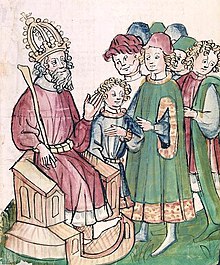|
Seven Wise MastersThe Seven Wise Masters (also called the Seven Sages or Seven Wise Men) is a cycle of stories of Sanskrit, Persian or Hebrew origins.  Frame NarrativeThe Sultan sends his son, the young Prince, to be educated away from the court in the seven liberal arts by Seven Wise Masters. On his return to court, his stepmother, the empress, attempts to seduce him. To avert danger he is bound over to a week's silence by Sindibad, leader of the Seven Wise Masters. During this time, the empress accuses him to her husband, and seeks to bring about his death by seven stories which she relates to the emperor; but her narrative is each time confuted by the Seven Wise Masters led by Sindibad. Finally the prince's lips are unsealed, the truth exposed, and the wicked empress is executed.[1] The frame narrative served as the flexible way to transmit tales to other listeners. OriginsThe cycle of stories, which appears in many European languages, is of Eastern origin.[1] An analogous collection occurs in Sanskrit, attributed to the Indian philosopher Syntipas in the first century BC,[2] though the Indian original is unknown. Other suggested origins are Persian (since the earliest surviving texts are in Persian) and Hebrew (a culture with similar tales, such as that of the biblical Joseph). The Eastern VersionThe Eastern version of the narrative, known as The Book of Sindibâd (Sindbād-nāmah or The Book of Seven Viziers),[3] is presumed to have originated from a lost 8th century Arabic source by a writer known as Musa.[4] and may be found in Syriac, Arabic, Persian, Greek, Hebrew, and Old Spanish. SyriacThe Syriac Sindban is one of the oldest extant versions of the narrative. Persian: Sindibad-namehThere are three versions in Persian, including one in verse, and two in prose, dating from the late twelfth century to the late fourteenth century.[4] One of the prose texts, by Nakhshabi, is the eighth night in hisTutinama story-cycle. Arabic: The Book of the Seven VizirsWhile the surviving versions of the Seven Vizirs are dated later than many of the other texts in the Eastern tradition, earlier versions are presumed to have existed. Greek: SyntipasThe Byzantine version of the text. Old Spanish: Sendebar, or Libro de los EngañosWhile there are version of the narrative in Old Spanish that adhere to the narrative patterns found in the Western or European traditions, Libro de Los Engaños is part of the Eastern tradition. Hebrew: Mischle SendebarThe Western TraditionHundreds of surviving European texts are known.[5] These normally contain fifteen tales, one for each sage, seven from the stepmother, and one from the prince; though the framework is preserved, only four of the commonest European tales are also found in the Eastern version.[6] DolopathosTravelling from the east by way of Arabic, Persian, Syriac and Greek, the work was translated from Greek into Latin in the 12th century by Jean de Hauteseille (Joannes de Alta Silva), a monk of the abbey of Haute-Seille near Toul, with the title of Dolopathos (ed. Hermann Österley, Strassburg, 1873). This was translated into French about 1210 by a trouvère named Herbers as Li romans de Dolopathos. The Seven Sages of RomeAnother French version, Roman des sept sages, was based on a different Latin original.[1] The German, English, French and Spanish chapbooks of the cycle are generally based on a Latin original differing from these. Three metrical romances probably based on the French, and dating from the 14th century, exist in English. The most important of these is The Sevyn Sages by John Rolland of Dalkeith edited for the Bannatyne Club (Edinburgh, 1837).[1] German: Sieben weise MeisterThe German adaptions of the Seven Sages tradition can be divided into several verse and prose versions, most of which follow the latin Historia but sometimes change the order or selection of the embedded tales.[7] The oldest known German version of the Seven Sages, Dyopcletianus Leben by Hans von Bühel, dates back to 1412,[8] whereas most of the surviving textual witnesses are from the 16th to the 18th century and often embedded into German adaptions of the Gesta Romanorum.[9] Literary scholars have repeatedly emphasized the popularity of the Sieben weise Meister in the late Middle Ages and early modern period in contrast to its marginalization in modern literary historiography.[10] Literary legacyThe collection later supplied tales that circulated in both oral and written traditions. Giovanni Boccaccio used many of them for his famous work, the Decameron.[citation needed] The Latin romance was frequently printed in the 15th century, and Wynkyn de Worde printed an English version about 1515. See:
The Seven Sages Society, founded in 1975, maintains a perpetual scholarly bibliography, with annual updates in its on-line and printed (free of charge) newsletter.[11] StoriesThe tale collection has been thought to contain the origins of the Aarne–Thompson–Uther tale type ATU 671, "The Three Languages".[12] The story tells of a commoner boy who can understand the language of animals, which converse among themselves that the boy will lord over their mother and father in the future. His parents expel him for such affront. After a series of adventures, the boy becomes a king or pope and returns to his family's house. His parents serve him with a water and a towel and he reveals his identity.[13] See also
References
SourcesWikimedia Commons has media related to Seven Wise Masters.
Further reading
|